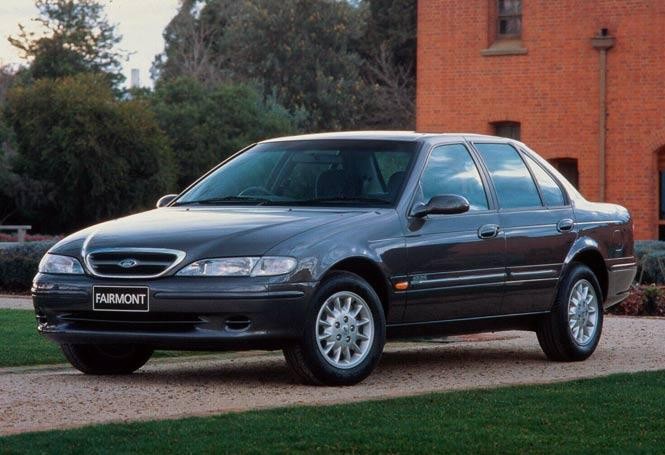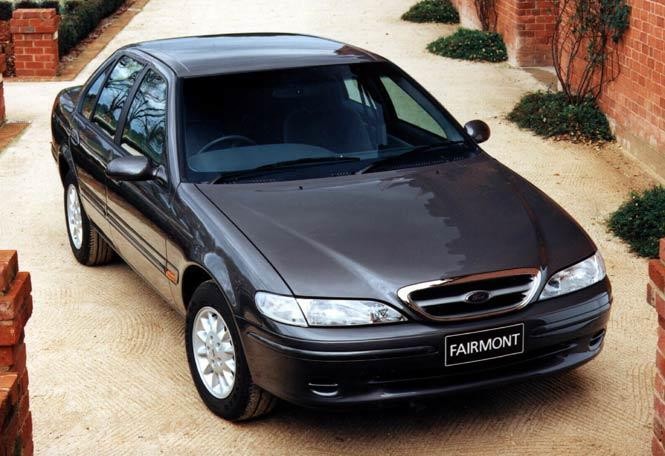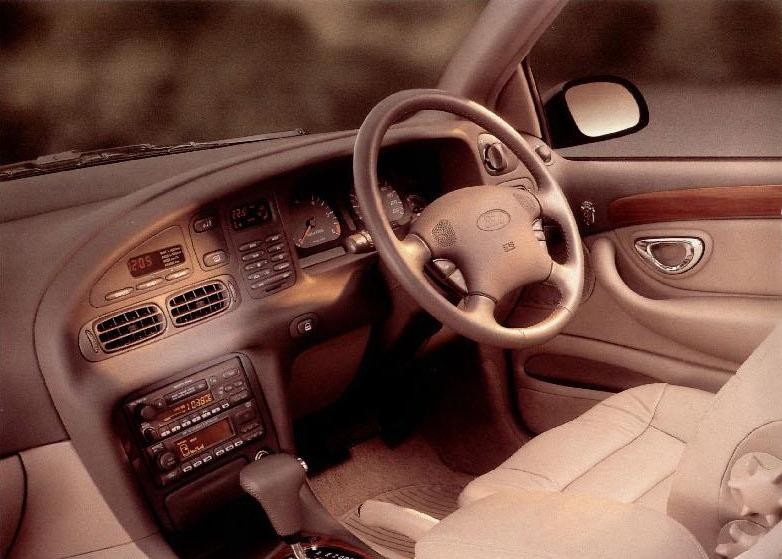
- Responsive engines
- Spacious interior
- Comfortable ride and predictable handling
- Folding rear seats add to cargo capacity
- Good visibility
- Vague steering
- Poor standard of fit and finish
- Inadequate air conditioning system
- Basic live rear axle suspension
Overview
Released in September 1996, the Ford EL Fairmont was available as sedan or wagon, while the Fairmont Ghia was solely as available as the former. Manufactured in Campbellfield, Victoria, the rear-wheel drive Fairmont was available with a 4.0-litre inline six cylinder or 4.9-litre V8 petrol engine. A four-speed automatic transmission was fitted as standard across the range.
Engines: I6 and V8
Of the engines,
- the 4.0-litre inline six cylinder engine had a cast iron block, an alloy cylinder head, single overhead camshaft (SOHC), two valves per cylinder and a compression ratio of 9.3:1; and,
- the 4.9-litre pushrod V8 engine had a cast iron block and cylinder head, two valves per cylinder and a compression ratio of 9.0:1.
EL Developments
Compared to its EF Fairmont predecessor, the EL Fairmont had a quieter cabin due to the introduction of thicker glass and additional dashboard insulation; the coil-pack ignition system was also replaced with a distributor. Visually, the EL Fairmont could be identified by its new bonnet, front bumper and headlights. Inside, there were reshaped seats and headrests, while the ‘Smart Tint’ window film provided SPF15 UV protection.
Dimensions
The EL Fairmont sedan was 4906 mm long, 1861 mm wide, 1453 mm tall and had a 2791 mm long wheelbase. The wagon models, however, were 136 mm longer (at 5042 mm), 5 mm narrower (1856 mm), 76 mm taller (1529 mm) and had 132 mm longer wheelbases (2923 mm).
Suspension
The EL Fairmont had Short Long Arm (SLA) front suspension and sedans had a live rear axle with four trailing arms and Watts linkages. For the EL, however, the rear suspension was revised to reduce roll oversteer by lowering the Watts link pivot point by 20 mm and changing the geometry of the rear upper arms; the front and rear spring rates were also reduced for greater ride comfort. Wagon models, however, continued with their Hotchkiss (leaf spring) rear suspension largely unchanged.
| Body | Engine | Trans. | Peak power | Peak torque | |
|---|---|---|---|---|---|
| Fairmont | Sedan, Wagon |
4.0-litre petrol I6 | 4sp auto | 157 kW at 4900 rpm | 357 Nm at 300 rpm |
| 4.9-litre petrol V8 | 4sp auto | 165 kW at 4500 rpm | 388 Nm at 3000 rpm | ||
| Fairmont Ghia | Sedan | 4.0-litre petrol I6 | 4sp auto | 162 kW at 4900 rpm | 361 Nm at 3000 rpm |
| 4.9-litre petrol V8 | 4sp auto | 165 kW at 4500 rpm | 388 Nm at 3000 rpm |
Safety equipment
Standard safety equipment included for the EL Fairmont consisted of a driver’s airbag and ABS; Fairmont Ghia models were further equipped with a front passenger airbag.
Features
Standard features for the EL Fairmont included 15-inch alloy wheels, six speaker sound system, climate control air conditioning, cruise control, velour seats, 60/40 split and folding rear seats, reote central locking, power windows and mirrors, a rake and reach adjustable steering wheel, height adjustable driver’s seat, trip computer and immobiliser; wagon models were also fitted with roof racks.
Beyond this, the EL Fairmont Ghia added a nine speaker, 250 watt sound system with a six-disc boot-mounted CD player, leather-trimmed seats, leather-wrapped steering wheel and woodgrain interior trim. The Fairmont Ghia was also fitted with speed-sensitive power steering and a limited slip differential.
Related links





